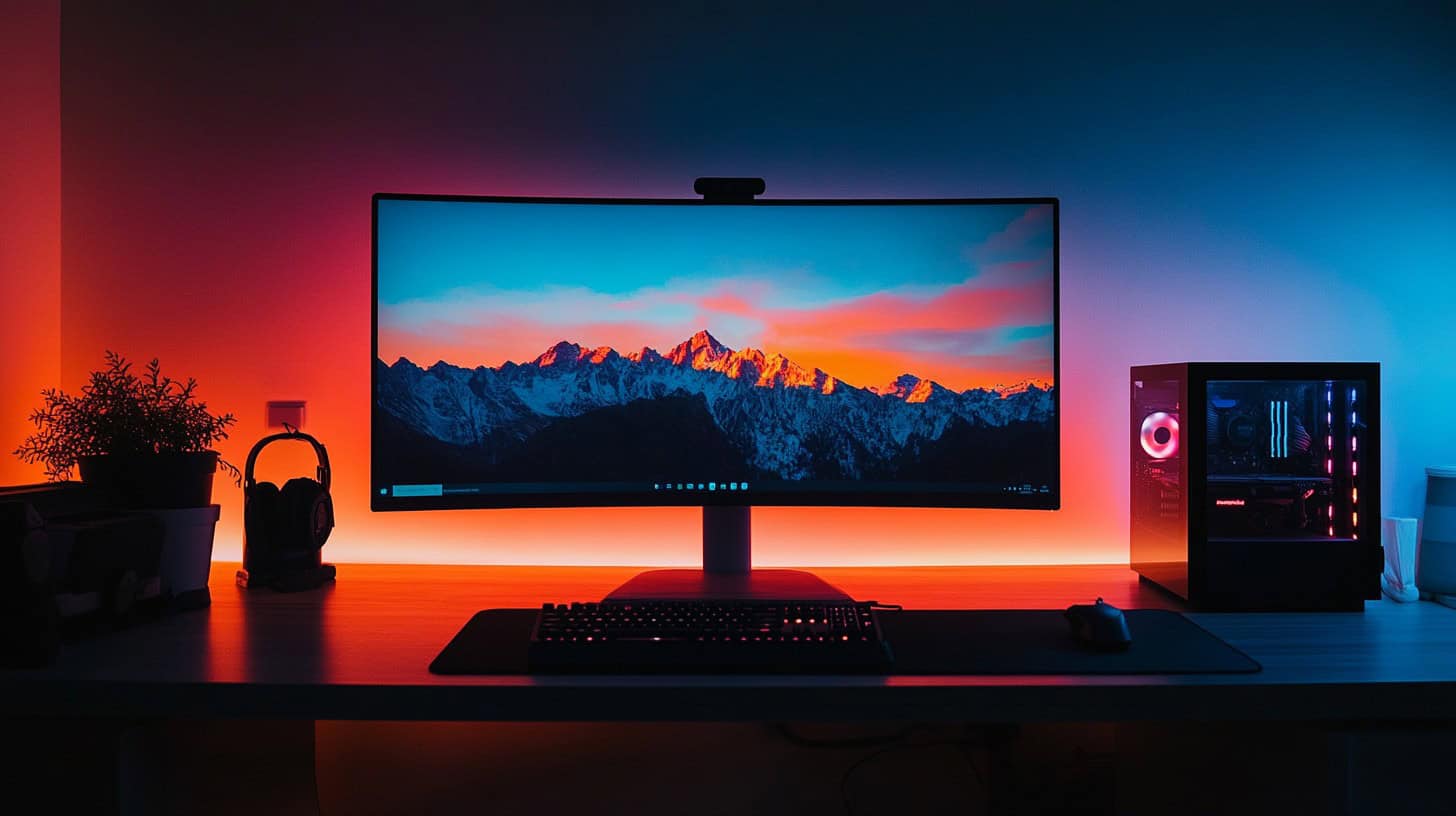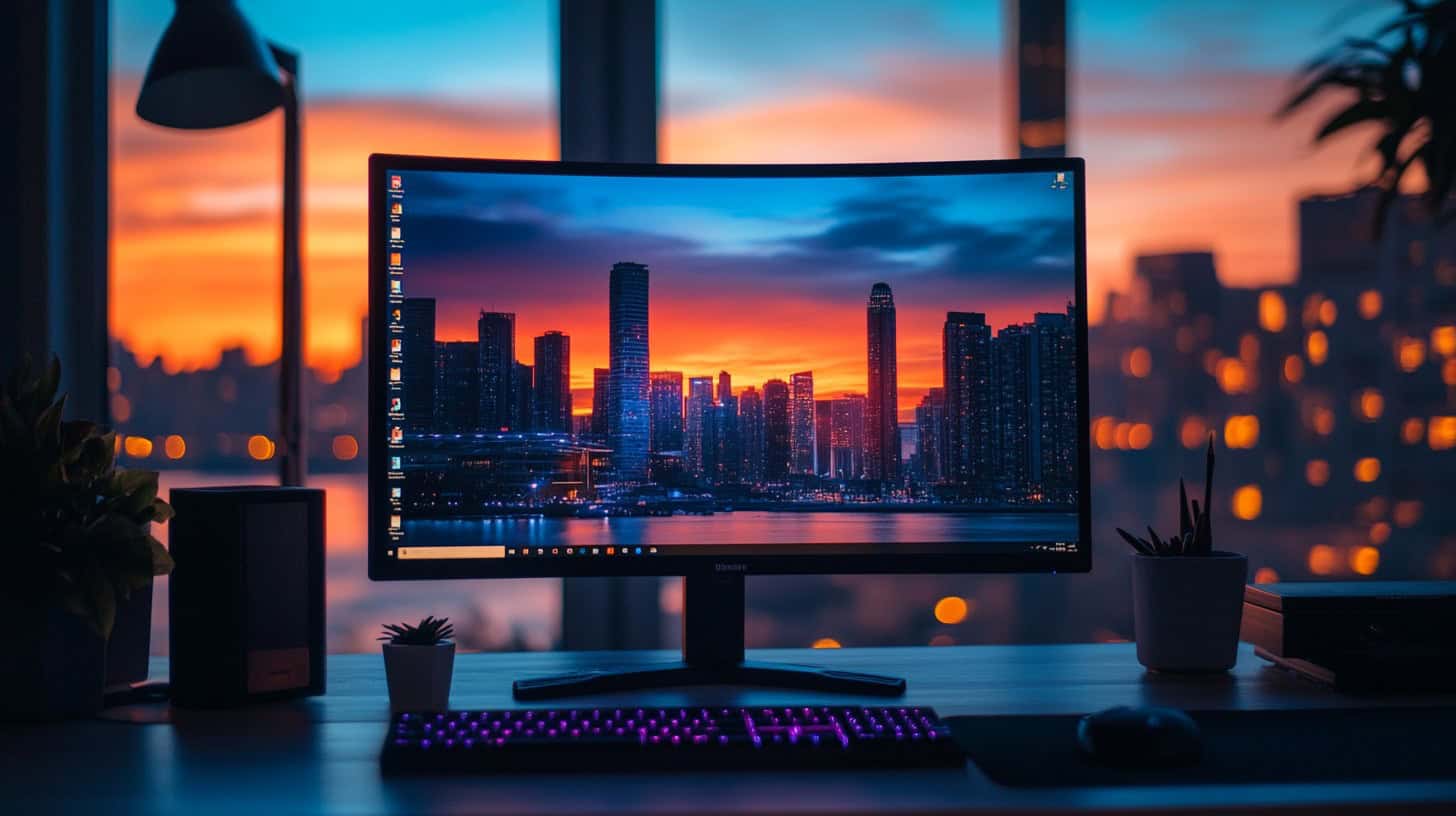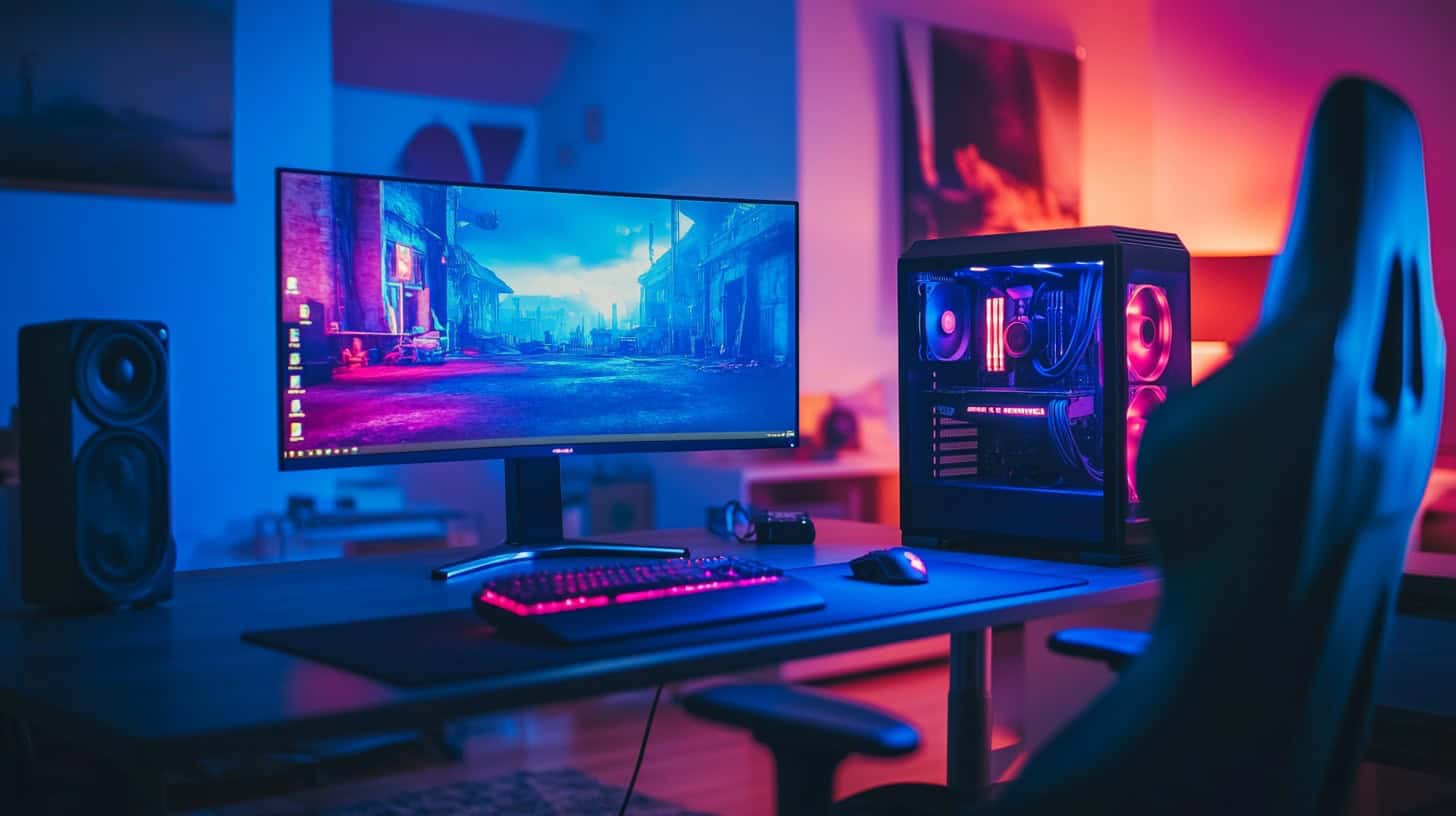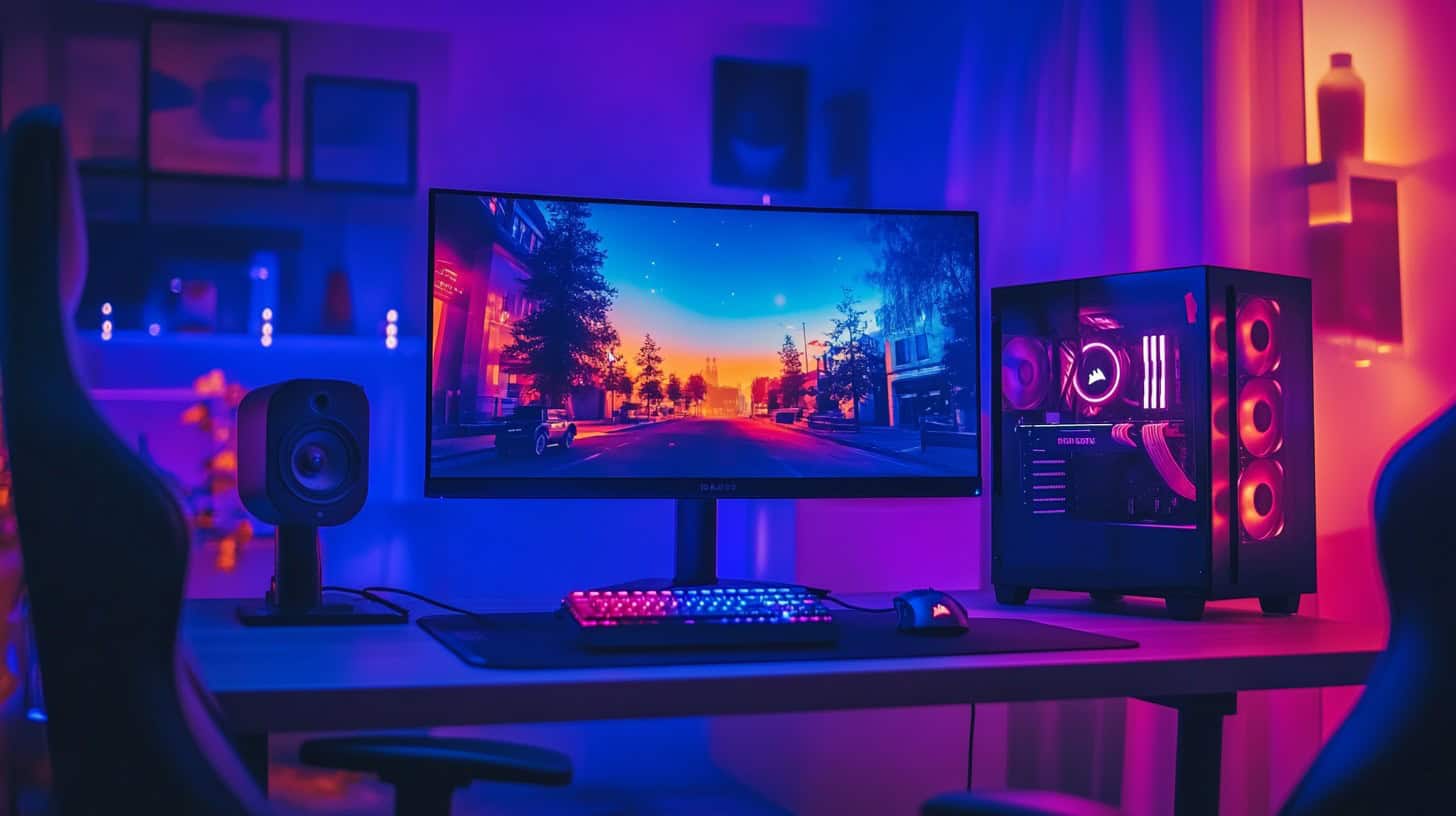Gaming monitors can make or break your gameplay. LCD and LED technologies dominate the market, but choosing between them isn’t easy. This guide reveals 5 key factors to boost your gaming performance.
I’ve spent 10 years testing and reviewing gaming displays. My experience shows that LED monitors offer superior color contrast and energy efficiency. 3 These advantages make LED screens the top choice for most gamers today. 2 Ready to level up your setup? Let’s explore the crucial differences between LCD and LED gaming monitors. 1
Key Takeaways
LED monitors offer brighter colors, better contrast, and higher energy efficiency compared to LCD monitors, making them the preferred choice for most gamers today.
LCD monitors are more budget-friendly but consume more power and have thicker designs, while LED monitors provide slimmer profiles and longer lifespans of up to 100,000 hours.
LED displays typically have wider viewing angles of up to 178 degrees, compared to 120-160 degrees for LCDs, which is beneficial for shooter games.
Gamers should look for monitors with low latency, fast response times (2ms or better), and high refresh rates (144Hz or 240Hz) for optimal gaming performance.
When choosing between LCD and LED, consider the trade-off between initial cost and long-term value, as LEDs are pricier upfront but offer energy savings over time.
Table of Contents
LCD Monitor Technology

LCD monitors use liquid crystals to create images. These screens rely on backlight technology to illuminate pixels, offering a balance of performance and affordability for gamers.
Functionality of LCD Monitors
LCD monitors use liquid crystals sandwiched between two polarizing filters. These crystals align to either block or allow light passage, creating the displayed image. An electric current controls this alignment, determining which colors appear on screen.
LED or CCFL backlighting illuminates LCD screens. Older models often use fluorescent tubes, offering lower brightness and efficiency. 1 Active-matrix LCDs provide better image quality than passive-matrix displays, with faster response times and improved color accuracy.
LCD technology revolutionized display screens, offering thinner, lighter alternatives to bulky CRT monitors. 2
Advantages and Disadvantages of LCD Monitors for Gaming
LCD monitors offer both benefits and drawbacks for gaming. Gamers should consider these factors when choosing their display:
- Cost-effective: CCFL LCD monitors are cheaper than LED alternatives, making them budget-friendly for casual gamers.
- Power consumption: Higher energy use compared to LED monitors, potentially increasing electricity bills for long gaming sessions. 3
- Thicker design: Bulkier than LED monitors due to CCFL backlighting technology, taking up more desk space.
- Environmental impact: Contains mercury, contributing to pollution at the end of the lifecycle.
- Uneven illumination: Noticeable in dark environments, affecting visual quality during low-light game scenes.
- Lack of local dimming: Limits contrast ratio, potentially reducing image depth in dark game areas.
- Adequate for online gaming: Suitable for Cash App casinos and other web-based games with less demanding graphics. 1
Next, we’ll explore LED monitor technology and its gaming performance.
LED Monitor Technology

LED monitors use light-emitting diodes as their backlight source. They offer brighter displays and better contrast ratios than traditional LCD screens.
Functionality of LED Monitors
LED monitors employ light-emitting diodes for backlighting, offering two primary configurations. Full-array backlighting distributes diodes evenly across the monitor’s back, ensuring uniform illumination. 2 Edge lighting positions LEDs around the perimeter, using a plastic sheet to spread light evenly. This technology excels in bright outdoor settings, utilizing additive color mixing to produce a wide color spectrum.
LED displays consist of tightly spaced LEDs that employ additive color mixing to create a broad spectrum of colors.
These monitors boast superior energy efficiency and vibrant image quality. 4 Let’s explore the advantages and disadvantages of LED monitors for gaming.
Advantages and Disadvantages of LED Monitors for Gaming
LED monitors have revolutionized gaming displays. They offer several advantages and a few drawbacks for gamers.
- Brighter Colors: LED backlighting produces vibrant, rich colors, enhancing game visuals. 3
- Improved Contrast: Local dimming in some LED monitors deepens blacks and brightens whites, creating more dynamic scenes.
- Energy Efficiency: LED monitors consume less power, reducing electricity bills for long gaming sessions.
- Slim Design: Thinner profiles allow for more desk space and easier multi-monitor setups. 2
- Higher Refresh Rates: Many LED gaming monitors offer 144Hz or higher, reducing motion blur and screen tearing.
- Lower Response Times: Faster pixel transitions minimize ghosting in fast-paced games.
- IPS Panels: Some LED monitors use IPS technology for wider viewing angles and better color accuracy.
- Longer Lifespan: LED backlights typically last longer than traditional LCD backlights.
- 4K Screens: LED technology powers many high-resolution displays, offering crisp imagery for detailed games.
- Potential Viewing Angle Issues: Edge-lit LED monitors may have reduced visibility at extreme angles.
- Higher Initial Cost: Quality LED gaming monitors often come with a premium price tag.
- Blue Light Emission: LED screens emit more blue light, which can cause eye strain during long gaming sessions.
Comparing LCD and LED Monitors

LCD and LED monitors differ in their backlight tech. Their contrast in image quality and viewing angles can impact your gaming experience.
Differences in Backlight Technology
LED monitors use light-emitting diodes for backlighting, while LCDs rely on fluorescent lighting. 5 Full-array LED backlighting distributes diodes evenly across the monitor’s back, providing uniform illumination.
Edge lighting positions LEDs around the monitor’s perimeter, using a plastic sheet to spread light evenly.
The choice between LED and LCD backlighting can significantly impact your gaming experience. 2
LCDs require an external light source, typically behind the screen. LED monitors offer two options: direct-lit (back-emitting) or edge-lit. These differences in backlighting technology affect image quality, energy efficiency, and monitor thickness.
LED-backlit displays generally produce brighter images and offer better color accuracy than traditional LCD screens.
Comparison of Energy Efficiency
Energy efficiency plays a crucial role in monitor selection for gaming. LED monitors outperform LCD monitors in this aspect. 2
| Factor | LED Monitors | LCD Monitors |
|---|---|---|
| Energy Consumption | 50-70% less energy | Higher energy use |
| Backlighting | Efficient LED technology | Constant CCFL backlighting |
| Power Usage | Lower power draw | Higher power requirements |
| Heat Generation | Less heat produced | More heat output |
| Environmental Impact | Reduced carbon footprint | Higher environmental impact |
LED displays consume half the energy of LCDs. 6 This translates to lower electricity bills and reduced environmental impact. Gamers benefit from cooler-running setups, enhancing overall system performance. The energy-efficient nature of LED monitors also contributes to their longer lifespan, minimizing the need for frequent replacements.
Contrast in Image Quality and Viewing Angles
LED monitors outshine LCDs in image quality and viewing angles. 2 LED displays offer superior picture contrast, wider color gamuts, and enhanced brightness.
| Feature | LED Monitors | LCD Monitors |
|---|---|---|
| Picture Contrast | Superior | Good |
| Color Gamut | Wider | Standard |
| Brightness | Enhanced | Moderate |
| Viewing Angle | Up to 178 degrees | 120-160 degrees |
| Edge-lit Visibility | Potential issues at angles | N/A |
LED displays boast a wider viewing angle of up to 178 degrees. LCDs offer a narrower angle between 120-160 degrees. Gamers playing shooter games benefit from LED’s superior angles. Edge-lit LED monitors may face visibility issues at certain angles. 7 Direct viewing minimizes this problem. Resolution, color accuracy, and contrast impact picture quality.
Comparison of Durability and Lifespan
LED and LCD monitors differ in durability and lifespan. Here’s a breakdown of their key differences:
| Factor | LCD | LED |
|---|---|---|
| Average Lifespan | 50,000 hours | Up to 100,000 hours |
| Backlight Technology | CCFL bulbs | Light-emitting diodes |
| Energy Efficiency | Lower | Higher |
| Heat Generation | Higher | Lower |
| Environmental Sensitivity | Less sensitive | More sensitive to heat and humidity |
| Content Impact | Less affected | Graphics-heavy tasks may reduce lifespan |
LED monitors boast superior durability due to their diode technology. They generate less heat, reducing internal stress. Their energy efficiency contributes to longevity. 5 LCD screens use older CCFL technology, limiting their lifespan. 4 Environmental factors play a crucial role in LED monitor longevity. High temperatures and humidity can degrade LED diodes faster. Graphics-intensive tasks may shorten LED monitor lifespans. Regular maintenance extends the life of both types. Proper ventilation helps prevent overheating issues. Adjusting brightness settings can preserve screen quality over time.
Choosing the Right Monitor for Gaming

Choosing the right monitor for gaming boils down to personal preference and budget… But knowing the key differences between LCD and LED can help you make an informed decision. Ready to level up your gaming experience? Let’s explore these five crucial factors!
Evaluate Gaming Performance
Gaming performance hinges on low latency and fast response times. Opt for monitors with a 2ms gray-to-gray response time or better. 1 TN panels excel here, boasting ~1ms response times – perfect for fast-paced action.
IPS panels offer a solid middle ground, with 4-8ms response times and superior color accuracy. VA panels, while slower, provide deep blacks and vivid colors.
For a competitive edge, consider refresh rates and adaptive sync tech. 144Hz or 240Hz displays minimize screen tearing and motion blur. Full-array LED LCD monitors with HDR capability deliver uniform lighting and enhanced contrast. 3 Match your monitor’s specs to your gaming rig’s output for optimal performance.
Analyze Cost Efficiency
Cost efficiency matters for gamers on a budget. LCD monitors offer lower upfront costs due to their established market presence. LED displays, while pricier, provide better value long-term with energy savings and longer lifespans. 3 A 24-inch 1080p LCD typically costs $100-$150, while comparable LEDs range from $150-$250. Higher resolutions and larger screens drive up prices for both types. Gamers should weigh initial investment against potential savings and performance benefits when choosing between LCD and LED options. 2
People Also Ask
What’s the main difference between LCD and LED monitors for gaming?
LCD uses liquid crystals, LED uses light-emitting diodes. LEDs offer better contrast and color.
How do refresh rates compare in LCD vs LED gaming monitors?
LED monitors often have higher refresh rates. This means smoother gameplay and less motion blur.
Which type of monitor is better for HDR gaming?
LED monitors, especially QLEDs with quantum dots, excel at HDR. They provide brighter highlights and deeper blacks.
Are curved monitors available in both LCD and LED?
Yes. Curved displays come in both LCD and LED variants. LED models usually offer better image quality.
How do LCD and LED monitors differ in power consumption?
LED monitors are more energy-efficient. They use less power, making them more environmentally friendly.
What about lifespan – do LCD or LED gaming monitors last longer?
LED monitors typically have a longer lifespan. They maintain brightness better over time compared to LCDs.
References
^ https://www.mmo-champion.com/threads/1088520-LCD-vs-LED-monitors-for-gaming (2012-02-28)
^ https://www.cdw.com/content/cdw/en/articles/hardware/led-vs-lcd-computer-monitors.html (2022-03-14)
^ https://www.gamespot.com/articles/lcd-vs-led-monitors-for-gaming/1100-6490253/ (2021-09-24)
^ https://www.jwslcd.com/lcd-vs-led-monitor-which-monitor-is-the-best-investment/
^ https://www.spiceworks.com/tech/hardware/articles/lcd-vs-led/ (2023-03-21)
^ https://medium.com/@kathyflow29/energy-efficiency-of-displays-lcd-vs-led-and-eco-friendly-considerations-ffabffc59470
^ https://www.hp.com/us-en/shop/tech-takes/differences-between-led-display-and-lcd-monitor (2020-05-11)



